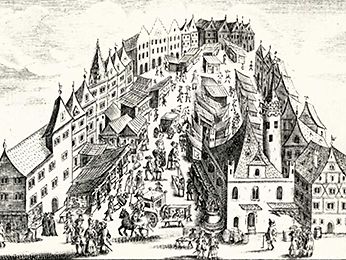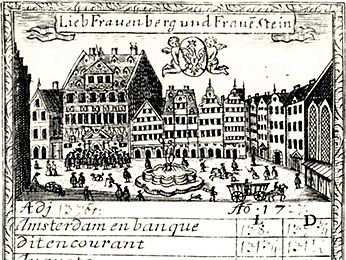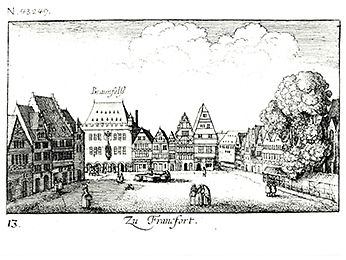Service Navigation
History of the Frankfurt Stock Exchange
History of the Frankfurt Stock Exchange
- Fairs, coins and bills of exchange: 11th - 17th century
- Patricians, princes and commodity markets: 18th - 19th century
- Wars, reconstruction, the computer age and cross-border growth: 20th century
Fairs, coins and bills of exchange: 11th - 17th century
The Frankfurt fair on the Römerberg
Copyright: Historisches Museum Frankfurt am Main
Already at the beginning of the sixteenth century, due to its well-known fairs Frankfurt had become so prosperous that Luther termed the city 'the silver and gold hole' of the German Empire. Through the immigration to Frankfurt of Dutch and French merchants who had been persecuted because of their Protestant belief, during the sixteenth century wholesale commerce and the banking sector also became established in Frankfurt. Merchants from all over Europe came to Frankfurt in order to engage in trade.
Since there was still no single currency neither in Europe nor in the German Empire, and the various countries fell apart into numerous small economic regions with their own monetary systems, payment was based on a large variety of coins. Because of this, monetary transactions in Frankfurt proved to be extremely troublesome. The confusing abundance of means of payment and the free exchange rates made it easy to engage in usury and swindles. To counter the deterioration of coinage, merchants at the fair met in 1585 in order to establish uniform exchange rates. Today, this event is regarded as the moment of the Frankfurt exchange's birth.
A quotations list from the Frankfurt stock exchange, 1727
© Historisches Museum Frankfurt am Main
The German term Börse (and French bourse) comes from the fifteenth century, from the Belgian city of Bruges. The word described a periodic meeting of rich Italian traders at ter buerse plaza – a market place that was named after the patrician family Van der Beurse, who had lived there (Lat. bursa = 'bag' or 'change purse').
Haus Braunfels at the Liebfrauenberg
© Historisches Museum Frankfurt am Main
In 1666, the first Exchange Rules and Regulations („Ordnung in Wechsel- und Kauffmannsgeschäfften“) were enacted, which led to the establishment of an official stock exchange administration. Initially, only trading in bills of exchange was undertaken on the Frankfurt exchange.


